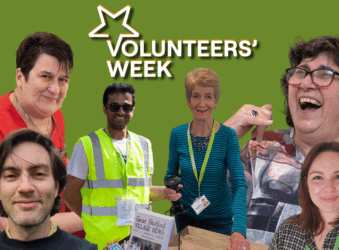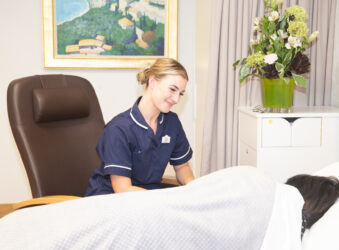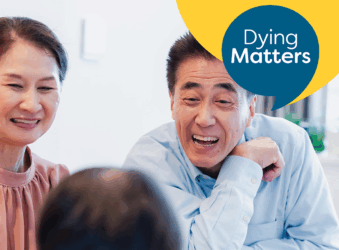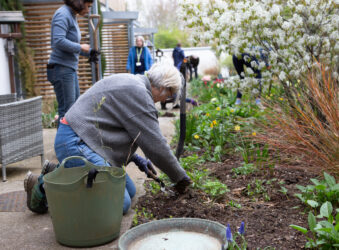An Unexpected Chapter – Inpatient Unit
Share this article
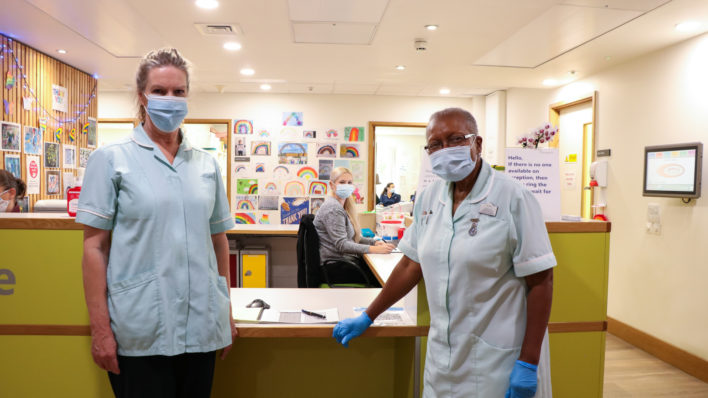
Anyone who has visited our Hospice knows that no two days are the same. This was taken to a new level earlier this year when it was necessary to put COVID-19 precautions rapidly in place.
We took some important time to reflect on these changes and ‘An Unexpected Chapter’ in our Hospice’s history.
An Unexpected Chapter for the Inpatient Unit. Part 1 – Keeping our services running
Our expert Inpatient Unit team provide outstanding care to patients with complex needs whilst also supporting nurse-led beds (find out more about nurse-led beds in the FAQ’s section of this website page). Care is holistic and individually tailored to patients and their families and loved ones.
We spoke to Jane Vandepeer (interim Ward Manager between October 2019 and September 2020) and Carly Love (Matron of Clinical Services) about the measures taken to ensure the Inpatient Unit could stay open and continue to deliver essential care after COVID-19 changed everything in April 2020.
As Jane and Carly explain, the biggest change due to the coronavirus pandemic, was probably the restrictions we had to put in place for patients’ visitors.
How things used to be…
JANE: Previously, depending on the patient, we were able to welcome as many visitors as they wanted. They were free to move around the unit and enjoy the patient and family lounge and breakout areas, as well as having access to the wider Hospice, Teen Den or Childrens’ Room, Bistro and our gardens. If a relative needed to stay overnight we were able to accommodate them in one of our two self-contained family apartments, which can be accessed via a staircase from the unit: we hope to be able to reopen this facility, if and when restrictions allow.
CARLY: When the pandemic first hit in March 2020, it was a huge challenge for the team, as the guidance was changing constantly, and things seemed to be changing almost every hour.
How we adapted…
Reducing beds to 19
JANE: Due to the requirements of spatial distancing, we have had to reduce our available beds to 19, when usually 21 are available.
In March, the number of patients we were caring for dropped significantly. We think this is because patients were reluctant to be admitted to a healthcare environment at that time. We had expected the numbers to rapidly increase as the pandemic progressed. Instead we have seen a more gradual increase over the last few months.
Zones & allocated nurses
CARLY: When the new Hospice at our Shelford Bottom site was designed, our team were heavily involved, as were all departments across the organisation. The Inpatient Unit really came into its own during the pandemic thanks to this consultative process which included a plan around future proofing. We were able to carry on and function, continuing to safely deliver care throughout.
JANE: Early on we had to zone-off a part of the unit as we were caring for patients who had tested positive to coronavirus. Thanks to the fact that the Ward was designed to have two wings, this was quite practical to do. We were able to effectively isolate these patients and those caring for them. Specific nurses were allocated to this zone on each shift to ensure the safety of the other patients we were caring for.
CARLY: There is access from this end of the Unit, to two family apartments. Whilst we have been unable to use these for their intended purpose during the pandemic, they were repurposed and used by the team caring for COVID patients, as a space where they could get changed and take their breaks.
PPE & safety precautions
JANE: All new patients arriving at the Hospice from the community are now screened on the day of admission and any hospital patients are screened prior to transfer.
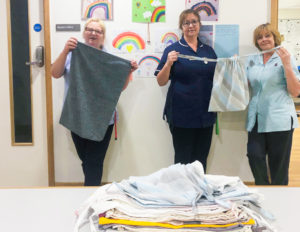 As soon as the pandemic first started, we began to barrier-nurse all patients and continue to do so now. This means wearing aprons, gloves and masks when we see each patient, regardless of whether they have been screened for COVID-19.
As soon as the pandemic first started, we began to barrier-nurse all patients and continue to do so now. This means wearing aprons, gloves and masks when we see each patient, regardless of whether they have been screened for COVID-19.
CARLY: When team members are caring for patients who have tested positive, they wear additional full PPE including more substantial FFP3 face masks, Perspex face-shields or goggles (depending on the colleagues’ individual preference) and scrubs. We had an incredible amount of home-made scrubs and masks donated by our wonderful Team Arthur community in an array of colourful patterns. These proved to be essential additions to our usual supply, which did not allow for number of changes needed between patients.
Redeployment of colleagues
JANE: A number staff from other teams, such as Day Therapy and Lymphoedema, were able to be redeployed onto the unit as healthcare assistants. This was a really positive experience and having their support and expertise made a huge difference.
CARLY: You might remember that when the first lock-down happened in April, it was really hot. Wearing PPE in such conditions can be really uncomfortable. We therefore put a system in place which enabled colleagues to do shorter stints on duty, with breaks in-between. This was flexed according to each colleague’s need, but having colleagues from different departments available to help made this more viable.
Challenges…
JANE: In order to follow government guidance, we had to cut down to one visitor per patient per day. This was probably the single biggest change and challenge for us because we’re usually so open, visitors can normally come and go without restriction. We were also unable to offer overnight accommodation for visitors. However, when a patient was approaching the end of life, we were able to relax the visitor rules due to exceptional circumstances.
Not being able to have contact with relatives because of the rules around spatial distancing has been hard. Not being able to comfort them and having to be physically distant when you’re talking to them is not what we are used to. The ‘comforting’ is such a big part of our care and that has been really hard for the team to get used to.
CARLY: Visitors were coming into patients’ rooms from the gardens and not through the building, so we didn’t get to build up relationships with family and loved ones as we usually would. Communal areas couldn’t be used and visitors were not able to wander around as they previously had. On top of this, our patients are vulnerable and would have been shielding had they been at home. This meant that the care team would only go into their rooms to do the jobs they needed to do, and then leave. We weren’t able to sit with in the same way as before. Of course, we also had to protect colleagues.
The start of it all was definitely the hardest. There was the added issue that information about COVID-19 was still only just coming to light. There was lots of uncertainty and stories in the media. We were all still learning about the disease. Visitors weren’t used to wearing face masks at that point and back in April and May it was really warm, making them even more uncomfortable. We all have a greater understanding now, of what we are dealing with, everyone has got used to wearing facemasks in shared spaces and are familiar with the ‘rule of six’. It wasn’t like that to begin with.
JANE: Having our new building made such a positive difference though. The extra space has made things so much easier than they might have been at our previous Mill Road site. Once restrictions were relaxed over summer, visitors were able to access relatives’ rooms via the gardens and for a time we were able to open some of the communal spaces.
Innovation and learning…
iPads and Facebook portals
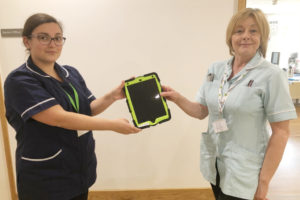 JANE: Something which helped make a real difference to patients and their loved ones, was having access to iPads and 10 Facebook portals. Many of the iPads were donated from the community after we launched an appeal on social media and portals were provided by the NHS X for remote communication (NHS X are responsible for driving forward the digital transformation of health and social care).
JANE: Something which helped make a real difference to patients and their loved ones, was having access to iPads and 10 Facebook portals. Many of the iPads were donated from the community after we launched an appeal on social media and portals were provided by the NHS X for remote communication (NHS X are responsible for driving forward the digital transformation of health and social care).
This meant that patients could still have face-to-face video contact with their families and friends, when they weren’t able to be physically in the same room. This mode of contact is something that we have found works very well and we are pleased to now be able to offer it to patients in the future too, thanks to devices generously gifted to us during the first wave of the pandemic.
CARLY: The Facebook portals were particularly good, because all that relatives needed in order to then contact their loved one on the Unit, was a WhatsApp account which allowed them to then make Facebook video-calls.
Community support
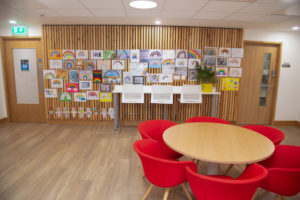 JANE: I’ve been overwhelmed by the local support we’ve had. People have made us masks and scrubs and brought in food and treats to keep us going. Children have drawn us rainbows and we’ve had so many cards and messages of support. These are on display on the wall behind the reception desk of the Inpatient Unit and have helped raise our spirits on the hard days. We even had deliveries of curry from local Indian restaurants. I’m not so much surprised – as people are so often this kind – but it was overwhelming.
JANE: I’ve been overwhelmed by the local support we’ve had. People have made us masks and scrubs and brought in food and treats to keep us going. Children have drawn us rainbows and we’ve had so many cards and messages of support. These are on display on the wall behind the reception desk of the Inpatient Unit and have helped raise our spirits on the hard days. We even had deliveries of curry from local Indian restaurants. I’m not so much surprised – as people are so often this kind – but it was overwhelming.
CARLY: As a Unit, when the pandemic first began, we were dealing with one scariest time we’ve had in nursing, so far. It was the uncertainty of everything, like it was for everyone. We didn’t know what the virus was going to bring and of course we were worried about taking it home to our families. But there was not a single day that went by, when we didn’t get support from the community, whether that was chocolates, flowers, pictures. And that meant to lot to the unit as we had some really tough times. It helped to get us through. Especially when the Police and Fire Brigade turned up on Thursdays and gathered to Clap For Our Carers.
The patient’s point of view…
CARLY: For patients and their families, those who were able to choose about coming into the Unit, it was a hard decision to make. They may have needed our specialist care, but compared to being at home in one place, it added potential risk of exposure to the virus. Also, if they were at home, it meant more family members, maybe five or six, could be with them. Being on the Unit meant restrictions in terms of contact with their family and the outside world.
As a team, we met every day to ensure we were adhering to government guidance, being safe – but also doing everything we could to support patients and their families. We never once closed entirely to visitors or introduced time restrictions, as some other facilities were forced to do. We knew this would impact patients and relatives, so did everything we could to enable visiting to continue, even when we had to restrict the number of people allowed to visit within 24 hours.
JANE: Despite the very difficult circumstances, at an already incredible hard time, patients, their families and visitors have been very understanding.
What’s next for the team…
JANE: As we have moved into this second lock-down the communal spaces have had to be closed again. The visiting rules are less restrictive than they had to be during the first lock-down. As of mid-November we are able to allow four visitors in 24 hours, but only two in a patient’s room at any one time.
[Editors note: for the latest information on visiting restrictions please click here to visit our ‘Latest news in response to COVID-19’ website page ].
We’re delighted that some of our Inpatient Unit volunteers were able to return when the first lock-down eased, and so far with this second lock-down, as long as they do not fall into the vulnerable categories, they are able to keep volunteering, if they wish. Many have chosen to carry on and we are enjoying their support and company as much as our patients and their families do.
It’s impossible to say at the moment, whether we will ever be able to return to our previous methods of working: it’s likely that we won’t be able to return completely to how it was before. Over time, COVID-19 may be something we treat like the flu, but we just don’t know at this stage, it’s too hard to say.
The Inpatient Unit would like to give a huge virtual (!) hug to the local community for their love and support during what has been one of the Hospice’s most challenging chapters. They also extend thanks to families who have shown such understanding during a difficult and uncertain time.
We strongly believe that the Hospice is a service for the people supported by the people, so all the well-wishes and thank you cards that the Inpatient Unit team have received, also extend to you:
“Thank you for the care and love you gave to our mother whilst she was with you. We could always leave after visiting her knowing she was with special people caring for her.”
Read ‘An Unexpected Chapter – Day Therapy’
Read ‘An Unexpected Chapter – The Patient and Family Support Team’
Read ‘An Unexpected Chapter for our Director of Fundraising and Communications
Related articles
-

Hospice Volunteers recognised during National Volunteers Week 2025
Arthur Rank Hospice Charity says thank you to over 600 volunteers
-

Hospice delighted with the results of Quality Assurance Visit
Quality assurance visit was conducted as part of the Cambridgeshire and Peterborough Integrated Care Board (CPICB)
-

The Culture of Dying Matters for patients at Arthur Rank Hospice Charity
Read how the Charity supports patients individual needs
-

Hospice Volunteer Gardeners makeover the Inpatient Unit gardens
Volunteer gardeners support Hospice patients and their loved ones

